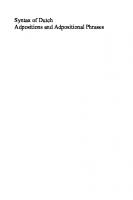Syntax of Dutch: Coordination and Ellipsis 9789048542895
The multi-volume work Syntax of Dutch presents a synthesis of current thinking on Dutch syntax. The text of the seven al
128 72 4MB
English Pages 392 [390] Year 2019
Recommend Papers

- Author / Uploaded
- Hans Broekhuis
- Norbert Corver
File loading please wait...
Citation preview
Coordination and ellipsis Abbreviations and symbols Preface and acknowledgments 1. General introduction 2. Main objective 3. Intended readership 4. Object of description 5. Organization of the material 6. History of the project and future prospects 7. Acknowledgments Introduction
iii v v v v vi xi xii xiii 1
Chapter 1 Coordination Introduction 1.1. General properties 1.2. Monosyndetic, polysyndetic and asyndetic coordination 1.3. Coordinands 1.4. Coordinators
3 6 6 46 59 113
Chapter 2 Ellipsis in coordinate structures Introduction 2.1. Conjunction Reduction 2.2. Gapping 2.3. Combining conjunction reduction and gapping 2.4. Conclusion
247 248 249 271 310 314
Chapter 3 Borderline cases of coordination? Introduction 3.1. Four supposed borderline cases 3.2. A note on the semantic side of gapping 3.3. Conclusion and a potential problem
315 316 316 332 334
Bibliographical notes
337
Glossary
339
Subject index
355
List of references
367
Abbreviations and symbols
This appendix contains a list of abbreviations and symbols that are used in this volume. Sometimes, conventions are adopted that differ from the ones given in this list, but if this is the case this is always explicitly mentioned in the text. References to the other volumes of the Syntax of Dutch. References to the chapters and sections in the other volumes in the series Syntax of Dutch are preceded by a letter: V + section # refers to the three volumes on Verbs and verb phrases; N + section # refers to the two volumes on Nouns and noun phrases; A + section # refers to the volume on Adjectives and adjective Phrases, and P + section # refers to the volume on Adpositions and adpositional phrases. P3.2, for example, refers to Section 3.2 in Hans Broekhuis (2013). Syntax of Dutch: Adpositions and adpositional phrases. Amsterdam: AUP. Symbols and abbreviation used in the main text °xxx refers to the xxx in the glossary Abbreviations used in both the main text and the examples AP Adjectival Phrase CP Complementizer Phrase DP Determiner phrase NP Noun Phrase Noun phrase Used when the NP-DP distinction is not relevant PP Prepositional Phrase TP Tense Phrase VP Verb Phrase Symbols, Abbreviations and conventions used in the examples t Trace (the original position of a moved element) XXX Small caps indicate that XXX is assigned contrastive accent Abbreviations used as subscripts in the examples 1p/2p/3p 1st, 2nd, 3rd person pl Plural acc Accusative dat Dative pred Predicate nom Nominative sg Singular Abbreviations used in the glosses of the examples AFF Affirmative marker COMP Complementizer: dat ‘that’ in finite declarative clauses, of ‘whether/if’ in finite interrogative clauses, and om in infinitival clauses prt. Particle that combines with a particle verb PRT Particle of different kinds REFL The short form of the reflexive pronoun, e.g., zich; the long form zichzelf is usually translated as himself/herself/itself
iv Syntax of Dutch: Coordinations and ellipsis Diacritics used for indicating acceptability judgments * Unacceptable *? Relatively acceptable compared to * ?? Intermediate or unclear status ? Marked: not completely acceptable or disfavored form (?) Slightly marked, but probably acceptable no marking Fully acceptable % Varying judgments among speakers # Unacceptable under intended reading $ Special status: old-fashioned, archaic, very formal, semantically incoherent, degraded/unacceptable for non-syntactic reasons, etc. The nature of the deviation is normally explained in the main text. Other conventions xx/yy Acceptable both with xx and with yy *xx/yy Unacceptable with xx, but acceptable with yy xx/*yy Acceptable with xx, but unacceptable with yy (xx) Acceptable both with and without xx *(xx) Acceptable with, but unacceptable without xx (*xx) Acceptable without, but unacceptable with xx .. Alternative placement of xx in an example .. .. Impossible placement of xx in an example XX ... YY Italics indicate binding XXi ... YYi Coindexing indicates coreference XXi ... YYj Counter-indexing indicates disjoint reference Unacceptable with index i, acceptable with index j XX*i/j Unacceptable with index j, acceptable with index i XXi/*j Constituent brackets of a constituent XP [XP ... ] Logical symbols : Conjunction or distributive AND : Inclusive disjunction →: Material implication >: Larger than : Negation x: Existential operator p, q, ...: proposition letters ⊫: Entails : Is logically equivalent to : Intersection : Union : Element of
: cumulative AND ⊻: Exclusive disjunction ↔: Material equivalence









